
Benefits of Flying Probe Tester
Rest assured the in-circuit testing of a surface mount technology board assembly is fast and efficient with HIOKI’s FA1240 flying probe tester. The FA1240 tester offers a variety of benefits that conventional test equipment does not. Some of these benefits include fixture-less inspection for quick set up, and proficient testing of misplaced components, faulty components, and poor contacts. Through HIOKI’s unique method of resistance testing, the exclusive solder joint integrity test is able to assess solder joints rapidly, while simultaneously preventing board and component damage through the use of HIOKI’s soft-landing feature. HIOKI’s four terminal measurement function, one that our competitors do not offer, can detect minute differences between inadequate and high-quality soldering. The standard automated optical inspection function is much more reliable than a simple visual check, and will analyze a component’s displacement, presence, and polarity and so on. HIOKI’s flying probe machine test can be executed at a very rapid pace of up to 40 steps per second with a probing pitch of 0.15mm.
Key Features
Ultra-High speed measuring
Measuring rate up to 40 steps per second helps reduce tact times and can actually be used in fully automated production lines averting a bottleneck. This is indeed a unique strength of HIOKI’s flying probe testers.
Fine pitch inspection
Accurately and consistently test down to a lead pitch of 0.2 mm. This allows inspection of fine-pitch components that fixture based testers cannot execute reliably.
Supplementary vision inspection
Supplement overall inspection strategy with HIOKI’s standard vision function allowing for component presence/absence check, as well as polarity and displacement confirmation.
User-friendly interface
A completely revamped Windows 7 based user interface makes use of graphics-rich environment making productivity very intuitive and efficient. Competent and reliable testing achieved regardless of operator.
Wide inspection area
Wide range of board sizes can be inspected from 2″ x 2″ to 20″ x 18″.
Automatic position compensation function
Standard feature working in conjunction with high-precision mechanism that enables probing with extremely high accuracy. Debug process is simple and precise with use of a CCD camera for teaching data coordinates and creating offsets.
A wealth of options
A range of options and accessories available. An optimum system can easily be constructed to cater to customer needs.
Programming methods
- CAD conversion software (Siemens Test Expert)
- Gerber data creation system (Hioki’s alternative to CAD based method, ideal for EMS companies and CMs.)
- Manual teaching using CCD camera.
Loading system is standard SPEC
The board loading function is part of the standard package that makes it simple to establish an automatic inspection system. Interface for HIOKI standard equipment is also provided as standard setup including SMEMA compatibility.
High probing accuracy
Probing accuracy of ±100 µm and movement repeatability accuracy of ±50 µm, ideal for testing fine pitch assemblies for both shorts and open circuits.
Test order optimization
To minimize mechanical travel distance of the probes, the test order sequence is automatically optimized to increase efficiency and ultimately reduce cycle times.
Bad mark detection
The equipped CCD camera can be used for detection of inspection marks used for multiple-sample boards as well as inspection only involving the step of image detection of marks.
Coordinate data teaching
The standard equipped camera can be used for simple and accurate coordinate data input and data revision for debugging.
HIOKI Flying Probe Tester
Application for EV battery module
HIOKI’s flying probe tester FA1240 delivers high-speed, high-precision, fixture-less testing of battery module with four flying probes. Proprietary flying 4 terminal probes visualize the magnitude of weld defects based on resistance values and enable accurate testing of lithium-ion battery internal resistance.


